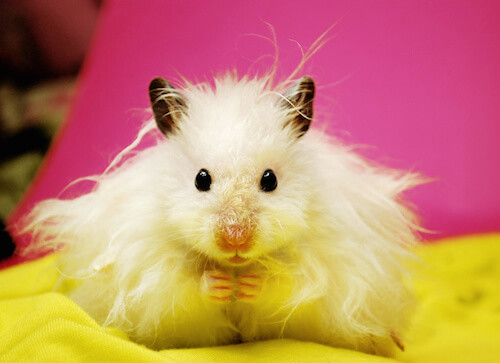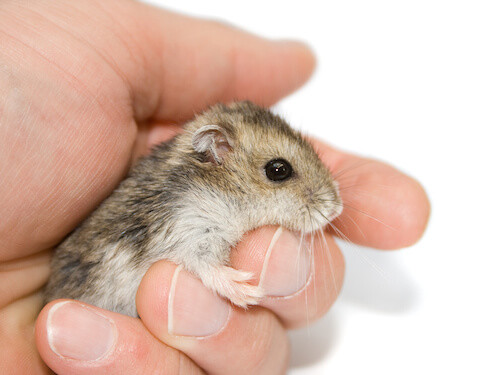Your hamster’s happiness can shine through in multiple ways depending on your hamster’s personality and interests. Some hamsters enjoy human attention and other hamsters find happiness in making burrows or through exercise.

The biggest issue of why your hamster might be unhappy is that its cage is too small. Hamster cages like those by Critter Trail let you connect additional cages or add tubes to make a larger living space. The great thing about these is you don’t have to spend a lot of money all at once. You can simply add on as or when you see fit.
The 6 Signs of a Sad Hamster
- Biting the cage
- Lethargic
- Climb the cage
- Excessive grooming
- Pacing
- Cage aggression
Charlotte Silcock from Rodent Life asked over 130 hamster owners ‘what is the biggest sign that you have a sad hamster’ and these are the main 12 signs they came up with.
Your Hamster is Biting Their Cage
This is a huge sign your hamster is unhappy… If they’re constantly biting their cage or trying to escape it’s a sign that their cage is too small.
Unfortunately, some big pet companies will misinform customers on how large their hamster’s cage needs to be and will often sell cages that are too small for hamsters. This is why it’s so important to properly research how big a hamster cage should be before you buy a hamster.
They are lethargic
A lethargic hamster is often a sign of an unhappy hamster. If all they’re doing is sleeping, eating, drinking, and sleeping again this is a sign that they are depressed.
Unless they’re old, it is not a good sign to see a hamster stuck in a loop of repetitive behaviors.
A happy hamster will be very energetic, wanting to explore its cage, use its wheel, and will be moving around much more.
They Climb Their Cage
Is your hamster climbing the bars of its cage or hanging from the top? This is another sign that their cage is too small and needs to be upgraded. It is often a sign of a bored hamster too.
You can try to stop this behavior by upgrading their cage and adding more toys into their cage.
Excessive Grooming
It’s perfectly normal for a hamster to groom itself if it’s a way for your hamster to clean itself. If they are excessively grooming then this can indicate a skin problem such as parasites, dry skin, unclean fur, mites, or a form of an allergic reaction.
Pacing
Pacing up and down or back and forth along the cage is another sign of repetitive behaviors and is often caused by stress. If not treated, then this behavior can become more often and severe.
To treat this, you need to find out what’s causing your hamster to be stressed. It could be loud noises, other household pets, small cages, or something else such as a dirty environment.
Cage Aggression
Another huge sign of an unhappy hamster is that they will start to become aggressive.
If you’re putting your hand in their cage and they’re biting it or being aggressive towards you, this is never a good sign.
Solutions to Consider
The most common issues relating to odd behaviors that are not illness-related can be addressed by providing enrichment, a larger habitat, and stress relief.
Chew Toys
Larger Habitat
Stress Relief
Related Reading:
Why Is My Hamster ShakingScared HamsterStressed Hamster Signs
How to Make a Happy Hamster
You can make sure your hamster is happy by providing them with the correct environment, affection, and entertainment. Charlotte Silcock has some great information on how you can improve your hamster’s happiness.
Signs of a happy hamster can vary from one individual to another, but there are some common indicators that can suggest your hamster is content and satisfied. Here are a few signs to look out for:
Here are 5 ways to make your hamster happy.
- Provide a large enough cage
- Maintain a clean cage
- Offer adequate food and water
- Provide daily affection to earn trust
- Keep the cage in a quiet location
Make Sure Their Cage is Big Enough
This is one of the largest problems pet hamsters face. You need to make sure your hamster cage is big enough as a small cage can cause a lot of stress which could lead to depression and your hamster become more open to illnesses.
Some signs your hamster’s cage is too small are:
- Cage Climbing
- Bar Biting
- Trying to escape
- Cage Aggression
If your hamster is climbing and biting the insides of the bar and trying to escape, then the likelihood is that the cage is too small for your hamster.
A small cage is common with domestic hamsters as companies such as pets4home will give out incorrect information about caring for hamsters and will often sell cages that are far too small.
Regular Cleaning
Making sure you spot clean your hamster cage often is important as a dirty cage will cause your hamster unneeded stress. However, you shouldn’t be fully cleaning your hamster cage unless it needs a proper clean.
By fully cleaning your hamster cage you are moving their whole home inside out which can make for a stressed hamster due to different smells and objects being moved. Imagine someone coming into your house and turning it upside.
By spot cleaning your hamster’s cage every couple of days you can make sure it remains clean for a longer time.


Enough Food and Water
Making sure your hamster has enough food and water is extremely important. You should be checking their water supply and keeping their food bowl topped up with a constant supply of dried food.
Hamsters love fruit and vegetable but should be given to them in small amounts as they can contain a high amount of natural sugars and water.
Treats such as hard-boiled eggs can be given to them once a week, for more ideas and understand of what treats you can feed your hamster check out Rodent Life’s article on best treats that your hamster will love list.
Daily Affection
By spending time daily with your hamster and letting them explore outside of their cage can make sure they get enough exercise. Happy hamsters love to explore and will certainly affect their overall happiness.
Therefore, it’s important to dedicate some time to your hamster regularly to let them run around inside a ball in a safe location outside their cage.
Place Their Cage in a Quiet Location
Loud noisy environments can cause additional stress on your hamster. They should be out of reach and away from other pets such as a cat or a dog.
Noises such as loud cars or music can create a stressful environment for your hamster that can lead to them becoming unhappy.
Signs of a Happy Hamster
- Active and alert behavior: A happy hamster will be active, curious and alert, moving around their cage, exploring their environment and playing with toys.
- Good appetite and drinking habits: A happy hamster will have a good appetite, enjoying their food and drinking water regularly.
- Healthy appearance: A happy hamster will have a shiny, well-groomed coat and bright, clear eyes. They will also have a good body condition, with no signs of illness or injury.
- Sociable behavior: A happy hamster will enjoy interacting with their human companion, responding positively to gentle handling and cuddles.
- Comfortable sleeping habits: A happy hamster will sleep comfortably, with no signs of stress or anxiety, such as restlessness or excessive sleep.
If your hamster exhibits these signs, it is likely that they are happy and healthy. However, it’s important to remember that each hamster is unique and may display their happiness in different ways.
Related Reading:
Happy Hamster Signs


Related Questions:
Is my hamster bored? A bored hamster will be very lethargic and sleep more than usual. They may start biting their cage or climbing up the bars, this is also a sign of stress.
How to relieve hamster stress? By making sure their cage is big enough, has enough toys, a clean cage that isn’t in a loud environment, and giving them regular attention will help relieve stress.
Is my hamster cage too small? If your hamster keeps trying to escape, climbs the bars inside of their cage, and is showing aggressive signs such as biting, then their cage may be too small.
Related Reading:
Are Hedgehogs Related to Porcupines?What Is the Largest Rabbit?
Reviewed By: Tim Winter


Tim Winter has a strong affection for pets and wildlife. His years of experience caring for various types of pets has led him to share his knowledge with others on the best practices in pet care. Tim holds a Bachelor of Science from the University of Oregon School of Journalism and Communications.
